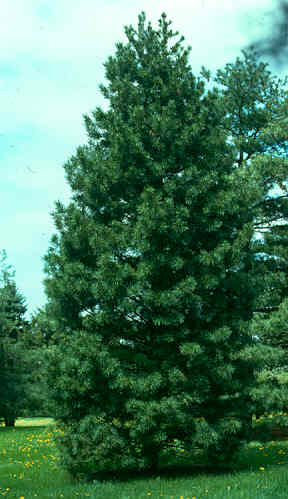The first time I saw Pinus cembra at the Morton Arboretum in Lisle, IL I fell in love with it. When I saw the same plant 50 years later, it was still looking good and only solidified my first impression. The tight pyramidal form and slow growth rate makes it the perfect pine for a small to medium-sized residential yard. In its native habitat it may reach heights of 80 feet but rarely exceeds 30 under cultivation.
I’ve always known this plant as the Swiss Stone Pine, but the preferred common name is now Arolla Pine, perhaps to avoid confusion with the Swiss Mountain Pine (Pinus mugo). Pinus cembra is native to the subalpine zones of the Alps and Carpathian Mountains of Switzerland, Austria, and Italy. Arolla is a municipality in Switzerland, hence the common name.
The dense, pyramidal form of a young Pinus cembra often flattens out and spreads with age. Growth rate is about six inches a year. It is long lived and extremely cold hardy. Ideally, soils should be slightly acidic and well-drained. Though the Arolla Pine prefers full sun, it will tolerate part shade, as is typical of most pines with needles in groups of five (Pinus aristata, Bristlecone Pine, is an exception; I’ll talk about this plant in two weeks).
Cones of Pinus cembra are about two to three inches long. The seeds are large, nutritious, and tasty. Cones cut into slices are used to flavor Schnapps. Such a product is sold as “Zirbenschnapps” (Litterally: “Pine liquor”). The aromatic wood is used for beds and furniture in Europe. Pinus cembra transplants easily and has no serious problems.
Not a lot of cultivars of Pinus cembra are readily available. The only one I grow is ‘Herman’ (Prairie Statesman®), which has lateral branches that curve markedly upward, producing a narrow erect form. This dense plant will mature at 25 to 30 feet with a 10 to 15 foot spread. Herbert Trautman, who owned and operated Trautman’s Nurseries in Franksville, WI for over 60 years and who died in 1996 at the age of 91, introduced four cultivars. The largest was ‘Big Blue,’ which at the age of 45 years was 27 feet tall and 12 feet wide. The foliage has a blue tint. ‘Twister’ was also 27 feet tall at the age of 45 but only nine feet wide. It has twisted blue needles. ‘Short Stuff’ is compact and dense, only reaching a size of 17 feet tall and eight feet wide after 45 years. Perhaps the best of his introductions, and most readily available today, is ‘Tip Top.’ This dwarf columnar plant was 20 feet tall and seven feet wide after 45 years.
Pinus cembra is sometimes difficult to find in nurseries, but if you see it, buy it. Consider it an investment for the next generation that can still be enjoyed in our lifetime.



